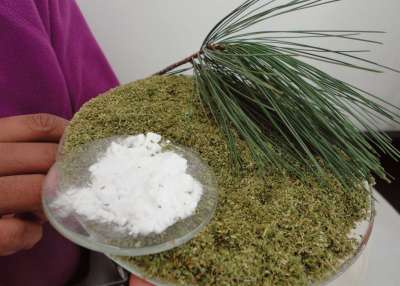If Ray Fort has his way, the next time you get the flu, the cure might just come from the needles of a New England pine tree. Fort, a chemistry professor at the University of Maine, has found that conifers – especially white pines – store an organic acid in their needles that is the starting point for making the anti-flu drug Tamiflu.
“Shikimic acid is a normal metabolite of all plants and most bacteria,” Fort said, meaning that they produce the acid as part of their normal growth. “Relatively few plants keep much of it around, though; they use it up on the way to making other compounds. But it appears that conifers store some of it.”
The manufacturer of Tamiflu, the Roche Group, presently acquires their shikimic acid from the star anise plant that grows only in the mountainous western provinces of China, where the annual plant is also harvested for use as a spice. In recent years, the price of this import has fluctuated between $300 and $700 per kilogram, with the higher prices paid during the peak of the swine flu and H1N1 pandemics. Fort hopes that Maine’s forest products industry can compete as domestic suppliers of shikimic acid.
Fort and a team of UMaine researchers have tested the needles of all of the conifers that grow in Maine and found that 1 to 3.5 percent of their weight is shikimic acid, with white pines near the high end of the range. He said the needles must be fresh, because as soon as the trees stop growing, they stop producing the acid.
“Our vision is that a logging operation would be accompanied by a truck, and on the back would be a device for grinding up the needles and cooking them in a vat of hot water like making tea,” he explained. “Then you drive the truck with the vat of tea back to a pulp mill where they do a chemical process to pull the acid out.”
He said that cooking up the tea is a trivial process and could even be done by smaller operations or individuals. They have even experimented with creating a giant muslin tea bag in which to brew the needles. “What’s hard is the separation of the acid from the tea,” he said. That process has been the primary focus of his ongoing research. He will soon begin working with an engineer to scale up the separation process to commercial size.
In a typical logging operation, the needles are left on the ground to decompose and return their nutrients to the soil, so they are essentially free, especially when compared to buying star anise from China. What about nutrient depletion? “There’s no reason you couldn’t make this tea and throw the residue back on the ground,” Fort said. “After you brew the tea, the needles can still return their carbon and minerals back to the soil. That makes it seem even more like the needles are free.”


